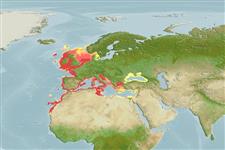Classification / Names
Common names from other countries
Main reference
Size / Weight / Age
Max length : 183 cm TL male/unsexed; (Ref. 247); 244.0 cm TL (female); common length : 150 cm TL male/unsexed; (Ref. ); max. published weight: 80.0 kg (Ref. 35388)
Length at first maturity
Lm ?, range 102 - 169 cm
Environment
Marine; brackish; demersal; oceanodromous (Ref. 51243); depth range 5 - 150 m (Ref. 247)
Climate / Range
Temperate, preferred 14°C (Ref. 107945); 63°N - 21°N, 19°W - 42°E
Distribution
Northeast Atlantic: southern Norway, Sweden and Shetland Islands to Morocco and West Sahara, including the Canary Islands, the Mediterranean and the Black Sea (Ref. 247). Range and abundance declining 1severely throughout its range; proposed legal protection in Britain (Ref.58085). Appendix III (Mediterranean) of the Bern Convention (2002). Annex V of the OSPAR Convention (2010). The European Council Regulations 43/2009, 23/2010, 57/2011, 44/2012, 40/2013, 43/2014, 2015/104 and 2016/72 prohibit to fish for, to retain on board, to tranship and to land the S. squatina in all waters from the European Community (F. Osaer, pers.comm. 04/2016).
Countries | FAO areas | Ecosystems | Occurrences | Introductions
Short description
Dorsal
spines
(total): 0;
Dorsal
soft rays
(total): 0. Broad flattened body, with enlarged pectoral and pelvic fins, no anal fin. Eyes and large spiracles dorsally. Gill openings at the sides of the head. The mouth is terminal. Coloration variable, from grey to reddish or greenish-brown with scattered small white spots and blackish dots dorsally (Ref. 78469). No ocelli on body (Ref. 247).
IUCN Red List Status (Ref. 115185)
Threat to humans
Traumatogenic
Human uses
Fisheries: minor commercial; gamefish: yes
Tools
Special reports
Download XML
Internet sources
Estimates of some properties based on models
Phylogenetic diversity index
PD50 = 0.5000 many relatives (e.g. carps) 0.5 - 2.0 few relatives (e.g. lungfishes)
Trophic Level
4.1 ±0.5 se; Based on diet studies.
Resilience
Very Low, minimum population doubling time more than 14 years (Fec=9-20)
Vulnerability
Very high vulnerability (85 of 100)
Price category
